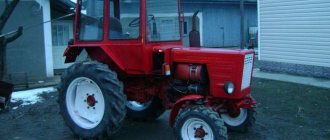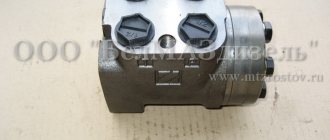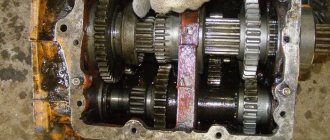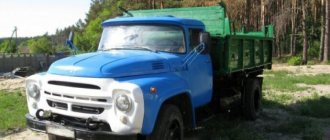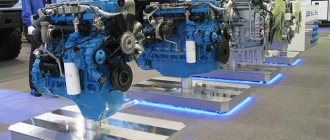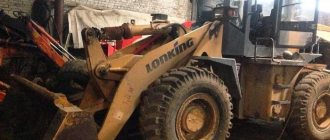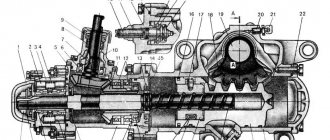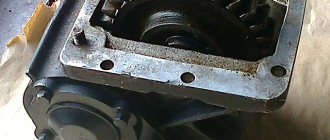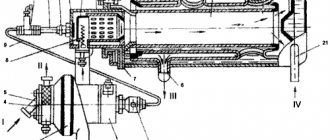T40 reverse repair
The reverse flies out, almost everyone has changed it, who knows what the problem is.
There is wear in the retainer cover.
Yes, on the sliders in these tractors it is a disease or two speeds can turn on at once
"birch" writes: I'm having trouble with the reverse, it keeps crashing. Replaced the fork and gear hub, no use. Can anyone tell me the details of the repair?
See the gear shift lock mechanism. There may be a large hole at the point where the locking roller contacts the reverse roller.
Moved from the topic “all about T-40 tractors” Files: rewers.jpg rewers_0.jpg
_______________________________________ “Do what you can, with what you have, where you are.” Theodore Roosevelt ©
birch Remove the gear shift lever along with the cover. On the right, as the tractor moves, you will see holes in which the springs and ball should be located. They are used to fix the shafts when changing gears and reverse. So, look if everything is in place. If that’s all, then cut off the bolt from the 10th bolt and place it on the spring under the cover and screw it back on. Most likely the spring has weakened and there is not enough strength to resist. Something similar happened with the speed jumping out. I solved the problem this way.
birch Remove the gear shift lever along with the cover. On the right, as the tractor moves, you will see holes in which the springs and ball should be located. They are used to fix the shafts when changing gears and reverse. So, look if everything is in place. If that’s all, then cut off the bolt from the 10th bolt and place it on the spring under the cover and screw it back on. Most likely the spring has weakened and there is not enough strength to resist. Something similar happened with the speed jumping out. I solved the problem this way.
There should be a ring there. I was sorting out mine that year, I didn’t have it. Well, I didn’t bet either. Doesn't matter! All the same, the shaft has nowhere to go.
_______________________________________ “Do what you can, with what you have, where you are.” Theodore Roosevelt ©
Valu just has a place for me to go. squeezed out and broke the cover, the shaft came out with 406 bearings. I looked at the plunger clamp, yes there is wear, but it looks like it needs to be changed, the gap needs to be disconnected by 2 cm
Valu just has a place for me to go. squeezed out and broke the cover, the shaft came out with 406 bearings. I looked at the plunger clamp, yes there is wear, but it looks like it needs to be changed, the gap needs to be disconnected by 2 cm
I got the sides mixed up. On the left, where the 212th bearing is, there should be a large retaining ring in the cup (I don’t have one) And on the right, where the 406th bearing is there, the ring is only on the shaft and the bearing in the cup is held in place by the cover. What just took and squeezed out? Files: korobka.jpg
_______________________________________ “Do what you can, with what you have, where you are.” Theodore Roosevelt ©
what about the gearbox slider retainer, how to get it
I don't remember exactly now. Last winter I pulled it out, but the box was completely disassembled, including the unscrewed gap. You have to look at it yourself.
_______________________________________ “Do what you can, with what you have, where you are.” Theodore Roosevelt ©
the reverse crashes, changed almost everyone who knows what the problem is
What exactly did they change? The point is that the reverse gears need to be changed in pairs. I had this problem. When driving forward, it sometimes knocks out, I took it apart and saw that the splines on the reverse gear (hypoidal) were licked inside, I had to swap the gears from the input shaft to the reverse housing and then slightly correct the licked teeth with a file (remove the roundness). All this was done due to a salary shortage. After this procedure, I felt a little better, it stopped knocking forward, and it knocked back, but less often than before. Then I found the entire reverse repair kit and changed all 4 gears and the cup. The problem disappeared as if by hand. Moreover, I noticed that when the bolts securing the gear shift lever are tightened, it knocks out more often, and when they are loosened and the body moves a little, it knocks out much less often.
Source
Service
For reliable, long-lasting operation and reducing the number of repairs to the T-40 tractor gearbox, it is necessary to perform maintenance regulated by the manufacturer.
An important operation is to check the quality, level, and service life of the lubricant in the box body. High-quality transmission oil will protect gears and shafts from premature wear and corrosion.
It is necessary to use a lubricant with a specified temperature regime for periods of operation (summer, winter, all-season).
The frequency of checking the oil level is performed every 240 operating hours. Check the level using the control plug, which is located on the gearbox housing.
If the level is low, fill the oil to normal through the control hole. It is strictly not recommended to fill transmission fluid above the level of the control mark, as this will lead to the creation of an increased density of the oil film on the gear teeth, which causes deformation.
When changing transmission fluid, every 960 operating hours it is necessary to flush the elements and components of the box. To do this, the oil is drained from a hot engine, which allows the box to be cleared of deposits.
Also, in the T-40 gearbox, the meshing value of the gear teeth is not adjusted until the gearbox is completely inoperable.
Performing such simple operations will allow for high-quality maintenance of the gearbox and increase the service life of the multifunctional T-40.
Reverse of T-40 Vladimirets
As we indicated above, the T-40 has a reversible manual transmission. Thanks to the reverse gearbox, rotation of the drive shaft to the clutch is ensured.
A reverse gearbox is a device that is made in the form of a gearbox, with the addition of gears, which allows you to change not only the speed of rotation, but also its direction.
Also, a reverse gearbox allows you to obtain additional gears and increase the productivity of the tractor unit and improve its ease of operation.
Operating principle and reverse circuit T-40
Below we show a diagram of a bevel gear with a reverse mechanism.
The T-40 reverse tractor consists of a bevel gear, two driven wheels and a gear coupling. The hub of the drive gear at the front rests on a ball bearing, which is located in the walls of the housing, and at the rear it rests on a roller bearing.
There is a spacer between the bearings. Using splines, the gearbox input shaft connects to the hub. The right gear rotates between two bearings at the end of the shaft, and the left gear rotates on the side bearings.
The reverse gear clutch is placed on the drive shaft (the splined part of the shank); it is inserted into the hook through the gear rims. Using an external lever mounted on the shaft, the clutch receives movement to the left or right, and it also connects the shaft to the corresponding gear.
In this case, the shaft itself receives rotation in the required direction, respectively, forward or reverse movement of the T-40 tractor. The driven shaft is placed on two bearings, and two gears are placed on it (2, 3, 5 and 67 gears).
There are also two movable gears on it, one of which is the first and slowing gear, and the second is the 4th and reverse gear.
The drive shaft gear is in constant mesh with the big one, and the intermediate one with the retarding one, all this is fixed in the housing wall.
The gears themselves are switched by a lever located in a ball joint with a protective cover. The support itself is located in the power transmission housing. The rods connect the movable carriages through forks, and a roller is installed under them to act as a locking switching device. All this is connected to the main clutch pedal.
To work in special conditions of low gears, a speed reducer (gearbox with gear transmission) is installed on the T-40 tractor, but we examined its diagram in our other material.
Important! When installing a new reverse gear on the T-40, you need to adjust the lateral clearance of the gear hooks. It should be 0.15-0.5 mm.
Source
Technical data of the agricultural unit
Detailed operating instructions for the T-40 tractor allow you to learn the nuances and operational characteristics of the machine, which is designed for a wide range of agricultural work.
| Meaning | Options |
| Type and parameters of motor power | D-37 (37 hp); D-144(50 hp) |
| Total structural weight of the machine (depending on wheels) | 2300-2600 kg |
| Speed mode | From 1.6 km/h to 27 km/h |
| Engaging forward gears - quantity | 7 |
| Gear shift - reverse, quantity | 7 |
| Unit category | Traction class, type 0.9 t.p. |
| Machine length | 3660 mm |
| Unit width | 1620 mm |
| Equipment height | 2100 mm |
| Ground clearance for agricultural machinery | 500 mm |
| Adjusting track parameters | From 1200 to 1800 mm |
COMMENTS • 39
So the power supply suddenly began to shift into reverse, in reverse in any gear, I turn on reverse and in reverse, and in forward in any gear it shifts, tractor T 40, what could be the reason?
@Valik D it’s possible and I did it once
And also the food, reverse garna is a thing, but you can weld the reverse clutch until the last hour
